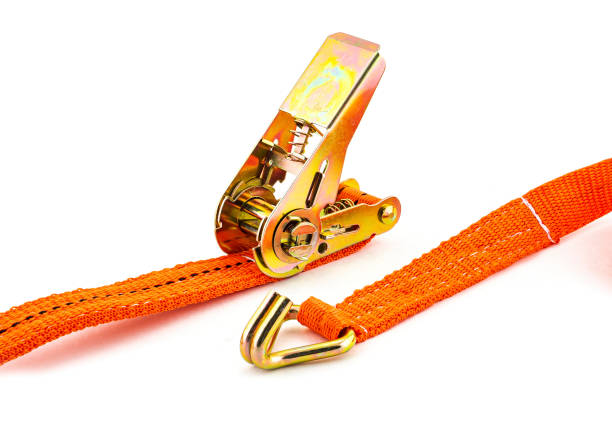Ratchet tie-down straps are crucial for securement of cargo during transport. However, every year these straps are damaged by misuse and storage.
To secure a load, the hook end of the strap needs to be attached to a stable anchor point on the truck or trailer bed. Then, the ratchet handle must be turned back and forth to secure the strap.
Instructions
Ratchet straps can be utilized by OTR truckers, professional movers, or to secure cargo onto the flatbed of your moving van, or pickup. These straps are unmatched in terms of strength and security and can also be used to stop the shifting of loads during transport.
A strap called a ratchet belt is an elastic strap that has been fabricated with tie-down hardware. Hardware is made up of fittings at the end of the strap to enable it to be attached to anchor points and then looped over or around cargo or equipment. Additionally, it has the ability to tighten and secure it to secure it in place.
When you’re ready to use your ratchet strap, first allow it to fully open in its flat position. In order to unlock the ratchet strap, you must first press the lever that releases it.
Close and open the ratchet until the strap feels secured, but not too tight. You’ll be able to tell if you overtightened the strap when you are unable to fit your finger between the strap and the object that is being secured. Once you’re satisfied with the outcome, turn the ratchet back into its closed position. Make sure you press it until it latches.
Secure Cargo
Whether transporting ATVs in a trailer, or lumber in a flatbed truck, there is one common goal, to secure the cargo to stop it from shifting in transit. Ratchet straps rated appropriately to the load is the best option to achieve this. The limit of a ratchet strap’s cao tang do load is calculated by taking its breaking strength, then dividing it by three.
Set both ends of the tie down straps through anchor points like rails, e-track or any other solid anchor points. You can pull the strap’s free ends through the slot on the ratchet. The free end of strap should not be too long because it could cause the ratchet to jam when tightening.
Once you’ve put the strap in the position you want it to be and then, you can use the ratchet tool to eliminate any looseness. Then, you can begin tightening the strap. Keep a finger on the ratchet handle to be aware when you’ve reached your maximum load that you can handle and when you have to stop. Make sure not to tighten too much the strap, since this could cause damage to your cargo and also cause the ratchet to break.
Proper Use
Ratchet straps are an essential trailer accessory for flatbeds that are designed for heavy-duty cargo safety. However, it’s easy to make a mistake with these straps, which could cause damage to your load or the ratchet itself.
Verify the webbing on the ratchet assembly as well as the ratchet handle for any signs of damage prior to using it. Lubricate the ratchet handle with applying dry silicone spray or WD-40 for smooth operation.
Then you can you can thread the loose end of the ratchet strap through the slot that is open on the mandrel. Ensure that there’s no slack in the webbing. Once the webbing is properly threaded, you can close and flip the handle of your ratchet to make sure it is tight around the load.
Repeat the process until you have reached the desired tension. Be careful not to over tighten as this could cause damage to your cargo or the mechanism that operates the ratchet. Use ratchets using the appropriate end fittings. This includes hooks that are flat or chains. When storing your ratchet rope, keep it out of direct sunlight, as in time, UV light could cause degradation of synthetic webbing.
Tie Down Strap Safety Tips
It is essential to examine the ratchet belts to see if there are signs of wear and damage regularly like you do with any other equipment or tool. Moisture is an issue for ratchet straps since it can lead to mildew and mold, and affect the polyester tie-down webbing the straps are constructed of.
A ratchet belt fading in color can also be a sign of degrade. The exposure to sunlight could result in webbing being weaker due to UV radiation It is recommended to keep these straps stored in places that are not exposed to direct light.
Lubricating the straps of ratchets is a good idea. This will help the hardware flow smoothly and avoid corrosion. Be sure to apply dry silicone sprays, as solvents like WD-40 could cause harm if they come into contact with the webbing.
Ratchet Strap Tightening Guide
The best way to make sure that your ratchet straps operate correctly and last for longer is to keep them maintained properly. Regular cleaning and lubrication will help to keep your ratchet straps operating in good functioning condition. They should be stored in a location that is dry and away from sharp corners or objects that could cause damage.
When you’re looking for ratchet straps, there are many different options to choose from based on your requirements for cargo security. There are a myriad of hooks and fittings for etrack (also called e-tracks), flat hooks, and wire hooks. Choosing the right end fitting can help keep your ratchet straps in good condition and secure while out and about.
When you are choosing ratchet straps, look for ones that have an easily-read working load limit tag them. It is illegal in a variety of states to utilize a ratchet strap that does not have one, and could mean you are at risk of being charged penalties or, even more seriously even being fired from your trucking position as a result of it. Make sure you select a Ratchet strap that is designed to be strong enough to hold the load it is rated for.




